From our favorite fruits to creative pizza topping combos, experience the delicious results of interactions between distant relatives of the tree of life. Explore foods that result from organismal pairings from entrées to desserts.
Better Together
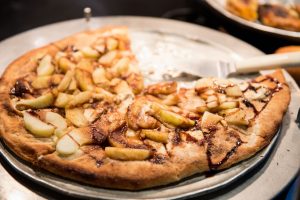 Culinary delights from interacting branches of the tree of life
Culinary delights from interacting branches of the tree of life
Ceva Pizza
Some of our most unique flavors result from combining distant branches of the tree of life. At Better Together, learn about ALL the ingredients in cheese and pickles and salami. Then, taste the results of using biodiversity to guide pizza topping selections – you’ll be sure to come back for a second slice! Click below to explore the menu and learn more about all the ingredients responsible for the flavors of this meal.
Menu
Artisanal Salami, Assorted Olives, Pickles, Kimchi, Sourdough Bread
Mushroom, Bleu Cheese & Truffle Pizza
Clam & Bacon Pizza
Pineapple & Ham Pizza
Sausage, Jalapeño & Sriracha Stromboli
Apple Dessert Pizza with Chocolate Sauce
More Information
Fermentation and your food: What is fermentation and what does it do?
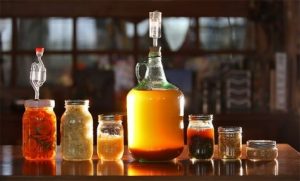 Peanut butter and jelly. Coffee and donuts. Cabbage and bacteria? Some foods are a match made in food heaven, while others just seem odd together, but some of the most delicious foods on Earth are produced from a marriage of very unlikely ingredients! Beer, bread, coffee, cheese, yoghurt, kimchi and pickles would not exist if not for the microorganism yeast (Saccharomyces sp.) and a group of diverse and prodigious bacteria known as Lactic-Acid Bacteria (LAB), which participate in the process of fermentation. Fermentation has been used in food production for thousands of years, and can be succinctly summed up as what happens when food technically “goes bad,” but stays good for you to eat. Fermentation involves the conversion of sugars into other compounds such as alcohols, allowing bacteria and yeast to produce unique flavors and textures, and to preserve food products for extended periods of time.
Peanut butter and jelly. Coffee and donuts. Cabbage and bacteria? Some foods are a match made in food heaven, while others just seem odd together, but some of the most delicious foods on Earth are produced from a marriage of very unlikely ingredients! Beer, bread, coffee, cheese, yoghurt, kimchi and pickles would not exist if not for the microorganism yeast (Saccharomyces sp.) and a group of diverse and prodigious bacteria known as Lactic-Acid Bacteria (LAB), which participate in the process of fermentation. Fermentation has been used in food production for thousands of years, and can be succinctly summed up as what happens when food technically “goes bad,” but stays good for you to eat. Fermentation involves the conversion of sugars into other compounds such as alcohols, allowing bacteria and yeast to produce unique flavors and textures, and to preserve food products for extended periods of time.
What fermented foods are in your fridge?
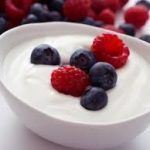
 Two main types of fermented foods are often household staples: fermented dairy products, which include yoghurt, cheese, and kefir milk, and fermented vegetables, which include cabbage (kimchi and sauerkraut), cucumbers (pickles), and olives. The fermentation of both dairy and vegetable products is carried out by several types of LAB, including Lactobacillus and Streptococcus. During the fermentation process, LABs produce compounds that not only enrich the foods we consume, but are also quite good for our health! Vitamin B-12, folic acid, biotin, as well as some prebiotic compounds that promote the growth of the good bacteria in your gut are some of the healthy essentials found in yoghurts, cheeses and other fermented products!
Two main types of fermented foods are often household staples: fermented dairy products, which include yoghurt, cheese, and kefir milk, and fermented vegetables, which include cabbage (kimchi and sauerkraut), cucumbers (pickles), and olives. The fermentation of both dairy and vegetable products is carried out by several types of LAB, including Lactobacillus and Streptococcus. During the fermentation process, LABs produce compounds that not only enrich the foods we consume, but are also quite good for our health! Vitamin B-12, folic acid, biotin, as well as some prebiotic compounds that promote the growth of the good bacteria in your gut are some of the healthy essentials found in yoghurts, cheeses and other fermented products!
Image Credits (right): How Stuff Works
But wait, there’s more!
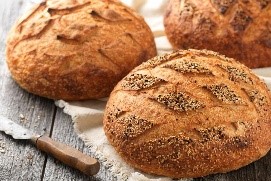 LABs can’t take all of the credit here. Yeast, molds like Penicillium, and other bacteria work together with these LABs to create salty, savory, and flavorful artisanal salamis and to bring us that delightful San Francisco sourdough bread. Salamis are the product of fermentation by LABs, which lower the pH of the meat and permit molds to flourish, giving these cured meats a tangy, unique flavor. Foods like salami and sourdough would not exist if not for human intervention, since yeasts and LABs generally do not interact with one another in nature! Perhaps the most interesting (and gross!) example of fermentation results in the production of Civet Coffee. Asian palm civets, small mammals from Asia, consume coffee cherries. As the coffee cherries pass through the civet’s digestive tract, it is fermented and enriched and later passed as fecal matter. This fecal matter is then collected and used to produce Civet coffee, which costs nearly five times the finest Arabica coffee!
LABs can’t take all of the credit here. Yeast, molds like Penicillium, and other bacteria work together with these LABs to create salty, savory, and flavorful artisanal salamis and to bring us that delightful San Francisco sourdough bread. Salamis are the product of fermentation by LABs, which lower the pH of the meat and permit molds to flourish, giving these cured meats a tangy, unique flavor. Foods like salami and sourdough would not exist if not for human intervention, since yeasts and LABs generally do not interact with one another in nature! Perhaps the most interesting (and gross!) example of fermentation results in the production of Civet Coffee. Asian palm civets, small mammals from Asia, consume coffee cherries. As the coffee cherries pass through the civet’s digestive tract, it is fermented and enriched and later passed as fecal matter. This fecal matter is then collected and used to produce Civet coffee, which costs nearly five times the finest Arabica coffee!
Image Credit: King Arthur Flour
Fermented foods and you: Keeping you healthy one bacterium at a time
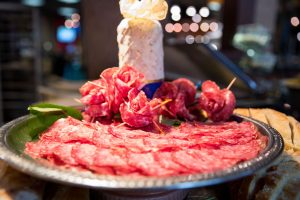 Fermented foods do not just taste good – they are good for you, too! The bacteria found in fermented foods are classified as probiotics, meaning that they work wonders for your gut health. The human gut microbiome is comprised of a community of bacteria and other variable microorganisms, and the foods that we consume can modify and contribute to the diversity of this collection of bacteria. In fact, clinical trials have been conducted to see if altering your diet to include more fermented food products can relieve symptoms of chronic gastrointestinal diseases, such as Irritable Bowel Syndrome (IBS), Crohn’s disease, and ulcerative colitis. Fermentation imparts food not only with added nutritional value, but also with unique flavors and textures. Fermentation lends us the creative space between rotten and fresh foods in which we find some of our most delightful delicacies and culinary achievements.
Fermented foods do not just taste good – they are good for you, too! The bacteria found in fermented foods are classified as probiotics, meaning that they work wonders for your gut health. The human gut microbiome is comprised of a community of bacteria and other variable microorganisms, and the foods that we consume can modify and contribute to the diversity of this collection of bacteria. In fact, clinical trials have been conducted to see if altering your diet to include more fermented food products can relieve symptoms of chronic gastrointestinal diseases, such as Irritable Bowel Syndrome (IBS), Crohn’s disease, and ulcerative colitis. Fermentation imparts food not only with added nutritional value, but also with unique flavors and textures. Fermentation lends us the creative space between rotten and fresh foods in which we find some of our most delightful delicacies and culinary achievements.
Additional Resources
http://discovermagazine.com/2003/sep/featscienceof
http://www.npr.org/2012/06/13/154914381/fermentation-when-food-goes-bad-but-stays-good
http://microbialfoods.org/visual-guide-salami-microbiology/
References
Adolfsson O, Meydani SN, & Russel RM (2004). Yogurt and gut function. The American Journal of Clinical Nutrition 80:245-256.
Buckenhuskes HJ (1997). Fermented vegetables. Food Microbiology: Fundamentals and Frontiers, eds Doyle PD, Beuchat LR, & Montville TJ (ASM Press, Washington, DC), 2nd Ed, pp 595-609.
Donovan SM & Shamir R (2014). Introduction to the yogurt in nutrition initiative and the First Global Summit on the health effects of yogurt. The American Journal of Clinical Nutrition 99(5 Suppl):1209S-1211S.
Farnworth ER (2008). Handbook of Fermented Functional Foods (CRC Press, Boca Raton, FL, USA).
Parvez S, Malik KA, Ah Kang S, & Kim HY (2006). Probiotics and their fermented food products are beneficial for health. Journal of Applied Microbiology 100(6):1171-1185.
Scott KP, Gratz SW, Sheridan PO, Flint HJ, & Duncan SH (2013). The influence of diet on the gut microbiota. Pharmacological Research: The Official Journal of the Italian Pharmacological Society 69(1):52-60.
Veiga P, et al. (2014). Changes of the human gut microbiome induced by a fermented milk product. Scientific Reports 4:6328.

This tree represents all 149 ingredients used at the Tasting the Tree of Life event. Blue branches represent the ingredients used at Ceva Pizza.
For the Love of Bees
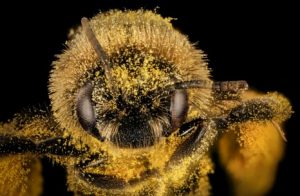
Sampling the fruit of pollination
Bliss Bakery
Whether you are biting into an apple or chopping up a zucchini, you are preparing a fruit which grows on a plant as the result of pollination. For many plants, insects are important pollinators – bees alone are responsible for pollination of nearly 1/3 of the world’s agricultural crops! Click below to explore the desserts on the menu and learn more about fruits of insect’s labor.
Menu
Honey Comb
Raspberry Blondie
Jewish Apple Cake
Peach Pie
Cherry Pie
Zucchini Bread
Fresh Cut Watermelon
Honey & Fig Pastry
Cardamon Crème Brûlée
More Information
How (and why?) are plants pollinated?
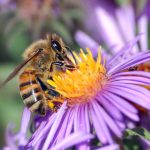
Pollination is an essential mechanism for plant reproduction. For plants to reproduce, pollen must be transferred from the male to female parts of a flower. As plants do not move, this is a significant challenge! Approximately 75% of flowering plants attract animals – mostly insects – to assist in pollination. Some examples of animal pollinators include hummingbirds, bats, flies, butterflies, and bees. Some plants are pollinated by the wind. Wind pollinated plants release their pollen into the air and rely on the currents of the wind to carry and deliver pollen to other flowers. Plants have many adaptations for wind and animal pollination. Animal pollinated plants tend to have very showy, scented flowers often with a reward such as nectar. Wind pollinated plants tend to have small, scentless flowers without showy petals (or no petals at all!) that are often greenish in color. Wind pollinated flowers, however, produce lots more pollen than animal flowers given the nature of their pollen dispersal mechanism.
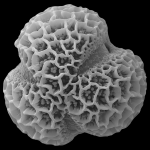
For a small insect, bees have a giant impact on pollination as as a result, life on earth. Bees and flowering plants have co-evolved over millions of years. As the poet Kahlil Gibran once said, “To the bee, a flower is the fountain of life, and to the flower, the bee is the messenger of love.” Bees’ eat nectar and pollen, which is found only on flowering plants. While traveling from flower to flower, the bee in return, transports pollen stuck to its legs and hairs to subsequent flowers. This pollen can rub off onto the reproductive organs of the flowers allowing for fertilization, and new seeds to develop.
Without pollinators, many plants would be unable to produce seeds. The endless combinations of cross-pollination between plants allows for genetic diversity in our plants; the more diverse our crops, the more resistant they are to diseases and pests. Genetically diverse crops result in the fittest plants, usually those with the highest seed count and largest sizes. Genetic diversity is essential to meeting future global challenges in relation to food and nutritional security. Although there are many pollinators of plants, one can argue that bees are among Earth’s most important pollinators.
Why should I care about bees?
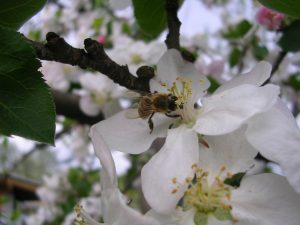
The well-choreographed exchange between bee and flower has created a dependence on bees to pollinate various crops. Current estimates indicate that bees pollinate one third of the world’s agricultural crops. As estimated 80% of the crops grown for human consumption rely on bees, and this doesn’t just include summer fruits. Many vegetables and nuts are dependent on bee pollination, as well as coffee, cocoa, tea, and cotton. Without these tiny workers, the human population would fall far short of its food needs.
In recent years, scientists have documented significant losses of bee colonies due to colony collapse disorder. This occurs when the worker bee population suddenly drops, leaving behind a hive that cannot be sustained. The Environmental Protection Agency (EPA) and others are still working to solve the mystery of colony collapse disorder. They have theorized that multiple stressors have led to the declining health of honey bees such as: pests, pesticide exposure, and loss of habitats. The loss of bees would have an astronomical impact on the agriculture industry. According to the National Resources Defense Council (NRDC), more than $15 billion worth of crops are pollinated by bees each year just in the United States alone. The loss of bees would damage the economy, our health, and the biodiversity of hundreds of species of earth.
Since bees make an essential contribution to ecosystems around the world and to human survival, it is imperative that we preserve them. You can help the bees in your own gardens by planting bee-friendly flowers, buying local grown organic produce, and avoiding chemicals and pesticides to treat your garden. For more information, visit the EPA website: https://www.epa.gov/pollinator-protection
What’s this art exhibit that’s all the buzz on campus?

Photograph by Brian Forrest
The TCNJ Art Gallery is excited present Jessica Rath: a better nectar opening on February 1st 2017. In this exhibit, Rath presents the multisensory communication between flowering plants and bumblebees through the use of audio and visual elements. The bumblebee differs from the honeybee in how it interacts with the flower. Upon visiting a flower, the bumblebee ‘buzzes’ the flower to release the pollen. Learn more and experience this interaction between bumblebees and plants in this immersive exhibit that provides a full sensory experience for a bee’s journey from nest to nectar. Jessica Rath: a better nectar is now open in the TCNJ Art Gallery and will be on exhibit until April 9th. If you are in the Science Complex you can also check out the pop up exhibit in the lobby of the Biology Building. For more information, visit: http://tcnjartgallery.tcnj.edu/2016/12/16/upcoming-exhibition-jessica-rath-a-better-nectar/
Additional Resources
http://nativeplants.msu.edu/pollination
References
Govindaraj, M., Vetriventhan, M., & Srinivasan, M. (2015). Importance of genetic diversity assessment in crop plants and its recent advances: an overview of its analytical perspectives. Genetics Research International. 2015: 431487
https://www.theguardian.com/commentisfree/2015/jun/17/why-are-bees-important
http://nativeplants.msu.edu/pollination
http://www.foxnews.com/food-drink/2012/07/19/10-crops-that-would-disappear-without-bees.html
https://www.epa.gov/pollinator-protection
http://www.queenofthesun.com/get-involved/10-things-you-can-do-to-help-bees/
http://www.uhbeeproject.com/materials/farmfare_2010.pdf
https://pollinator.org/pollinators.htm

This tree represents all 149 ingredients used at the Tasting the Tree of Life event. Blue branches represent the ingredients used at Bliss Bakery.
Delectable Digestible Dairy
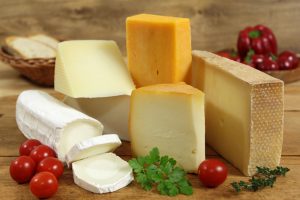 How we gained a taste for lactose
How we gained a taste for lactose
Roscoe’s Tacos
Got milk…or lactaid? As children most humans are able to digest milk without difficulty but as we age we begin to lose the ability to digest lactose, the main sugar in milk. However, this is no longer the case for a growing number of people. Click below to learn more about this change in human evolution and explore the toppings – with and without lactose – available at Roscoe’s Tacos.
Menu
Taco Beef, Taco Chicken, Fajita Shrimp, Fajita Steak
Brown Rice, Cilantro Rice, Refried Beans, Black Beans
Corn Salsa, Mango Salsa, Lettuce, Tomatoes, Onions, Sour Cream,
Guacamole, Cheddar Cheese (cow’s milk), Queso Fresco (cow’s milk),
Shredded Soy Mozzarella, Chevre (goat’s milk), Manchego Cheese (sheep’s milk), Cashew Cheese
More Information
What is lactose intolerance?
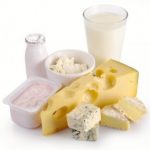 You’ve probably heard of the condition called lactose intolerance, which prevents certain unfortunate individuals from enjoying the delicious pleasures of cheese and ice cream without gastrointestinal side effects. These symptoms are a result of the body’s inability to digest lactose (the sugar found in milk) via an enzyme called lactase. But would you be surprised to learn that low levels of lactase activity is actually the norm in humans, while high lactase activity levels are unusual? In fact, about 70% of the world’s population cannot sufficiently absorb lactose!
You’ve probably heard of the condition called lactose intolerance, which prevents certain unfortunate individuals from enjoying the delicious pleasures of cheese and ice cream without gastrointestinal side effects. These symptoms are a result of the body’s inability to digest lactose (the sugar found in milk) via an enzyme called lactase. But would you be surprised to learn that low levels of lactase activity is actually the norm in humans, while high lactase activity levels are unusual? In fact, about 70% of the world’s population cannot sufficiently absorb lactose!
Image Credit: Authority Nutrition
How are humans changing… and why?
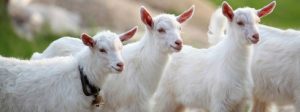 Starting at birth, infants and young children typically produce high quantities of lactase. However, the ability of individuals to produce lactase as they mature into adulthood varies around the world. Populations whose adults tend to be lactose tolerant always have an extensive history of pastoralism and milk consumption. In comparison, populations with fewer adults able to digest lactose often lack high levels of dairy consumption in their pasts. Given this pattern, the incorporation of milk and dairy products into the diet may have promoted increased tolerance for lactose in humans.
Starting at birth, infants and young children typically produce high quantities of lactase. However, the ability of individuals to produce lactase as they mature into adulthood varies around the world. Populations whose adults tend to be lactose tolerant always have an extensive history of pastoralism and milk consumption. In comparison, populations with fewer adults able to digest lactose often lack high levels of dairy consumption in their pasts. Given this pattern, the incorporation of milk and dairy products into the diet may have promoted increased tolerance for lactose in humans.
Strangely enough, one explanation for the frequency of lactase intolerance involves malaria defense. Malaria parasites require riboflavin— a B vitamin found in milk— in order to reproduce. Decreased milk consumption due to lactose intolerance, could result in riboflavin deficiency which might provide effective resistance against malaria reproduction.
Oddly, the latitude at which a population is located may have also altered levels of adult lactose tolerance. At higher latitudes there are lower levels of UV light, leading to decreased vitamin D synthesis— a vitamin that aids in calcium absorption. An increase in lactase production, however, would allow consumption of more diary, enhancing calcium absorption and ultimately help to fill the gap left by a vitamin D deficit.
Dairy and your diet
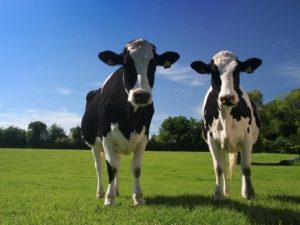 Despite growing knowledge of variations in lactase production in populations around the world, the extent to which milk should be consumed is still disputed. In the United States, groups including the National Dairy Council (NDC) and the United States Department of Agriculture (USDA) promote drinking milk for fitness. Meanwhile, organizations such as People for the Ethical Treatment of Animals (PETA) and groups promoting a vegan diet suggest that milk intake may not be ideal nor necessary. Though opinions vary, a common position is beginning to emerge— that individuals should tailor their dairy consumption to levels consistent with their unique physiological lactase levels. So, how about you? Got Milk?
Despite growing knowledge of variations in lactase production in populations around the world, the extent to which milk should be consumed is still disputed. In the United States, groups including the National Dairy Council (NDC) and the United States Department of Agriculture (USDA) promote drinking milk for fitness. Meanwhile, organizations such as People for the Ethical Treatment of Animals (PETA) and groups promoting a vegan diet suggest that milk intake may not be ideal nor necessary. Though opinions vary, a common position is beginning to emerge— that individuals should tailor their dairy consumption to levels consistent with their unique physiological lactase levels. So, how about you? Got Milk?
Additional Resources
http://www.nytimes.com/2006/12/11/science/11evolve.html
http://www.smithsonianmag.com/arts-culture/lactose-tolerance-and-human-evolution-56187902/
https://www.scientificamerican.com/article/lactose-toleraence/
References
Ingram, C. J. E., C. A. Mulcare, Y. Itan, M. G. Thomas, and D. M. Swallow. 2008. Lactose digestion and the evolutionary genetics of lactase persistence. Human Genetics 124: 579-591.
Lomer, M. C. E., G. C. Parkes, and J. D. Sanderson. 2008. Lactose intolerance in clinical practice—myths and realities. Alimentary Pharmacology and Therapeutics 27: 93-103.
Wiley, Andrea. 2013. ‘Drink milk for fitness’: The cultural politics of human biological variation and milk consumption in the United States. Pages 218-230 in D. L. Dufour, A. H. Goodman, and G. H. Pelto, editors. Nutritional anthropology: Biocultural perspectives on food and nutrition. Oxford University Press, New York.

This tree represents all 149 ingredients used at the Tasting the Tree of Life event. Blue branches represent the ingredients used at Roscoe’s Tacos.
